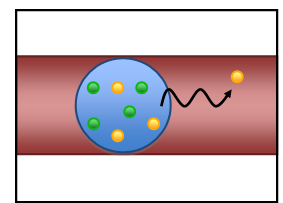Researchers in the Department of Chemical and Biological Engineering, Princeton University and in the Department of Pharmaceutics, Rutgers University have developed a targeted lung-specific delivery system which employs both passive and active targeting to intravenously deliver anti-cancer drugs to tumor cells as well as to reduce the occurrence of metastasis. The first layer of the delivery system is a gel microparticle (GMP) designed to take advantage of the venous lung filtration pathway and passively accumulate in the lungs after intravenous injection into the body. The second layer of the delivery system consists of two types of nanoparticles (NP) embedded in the GMP. The NP surfaces are decorated with ligands to actively target cancer cells. The first type of NP will be loaded with an anti-cancer drug, while the other type of NP will be designed to irreversibly bind to cancer cell surface receptors to inhibit metastasis. The release rate of the NPs from the GMPs into the tumor and the release rate of the anti-cancer drug from the NPs can be tuned to achieve the maximum desired effect. This dual-delivery system affords the ability to sustain a high concentration of anti-cancer drugs in the lungs while minimizing the systemic exposure and accordingly reducing the side effects. Additionally, it may actively prevent the spread of the cancer to other parts of the body.

Figure 1.Embedded with drug loaded nanoparticles (yellow) and metastasis inhibiting nanoparticles (green), the gel microparticle (blue) is trapped in a lung capillary (red). The nanoparticles are released overtime in the lung to kill cancer cells and prevent metastasis.
Background
The American Cancer Society estimated that in 2009, 1,479,350 new cancer cases would be diagnosed in the United States of which 219,440 would be lung and bronchus related. Although only the second most prevalent type of cancer, behind prostate and breast cancer for men and women respectively, lung cancer is the most lethal accounting for a projected 159,390 deaths in the United States. Non-small cell lung cancer (NSCLC), a subset of lung cancer, encompasses a set of diseases with similar prognosis and treatments. The standard treatments for NSCLC include surgery, chemotherapy, radiation, laser and photodynamic therapy, all with various success rates depending on the stage of the cancer. National Cancer Institute assesses, however, that results of standard treatment are generally poor with only a 15 percent 5-year survival rate for combined cancer stages. Challenges facing the current chemotherapy drugs include excessive toxicity to healthy tissues and limited ability to prevent metastases. The dual drug delivery system described herein aims to overcome these two challenges by selectively targeting the lung to deliver anti-cancer drugs and inhibit the formation of metastases.
The design of the human lung affords unique targeting options. Delivery via inhalation of anti-cancer drugs has been explored; however, low absorption and poor lung distribution of drugs has limited this avenue. A more promising approach involves passive targeting of the lung via the venous blood stream. The lung receives the entire venous blood supply from the heart and passes it through the intricate capillary beds on the alveoli. Large particles in the venous blood are thus trapped in these capillary beds. This filtering phenomenon can be used to selectively deliver particles to the lung. Such delivery methods have been safely employed in pulmonary perfusion diagnostic agents; however the use of this novel delivery route for chemotherapeutic drugs has not been appreciated or utilized by the drug delivery community. Initial IP for this mode of delivery has been filed by our collaborator, Dr. Patrick Sinko of Rutgers University, and additional IP on the production of nanoparticles and combination of the gel particles and specific drug formulations have been filed.
This dual GMP-NP delivery system has potential commercial application for treatment of Non-Small Cell Lung Cancer (NSCLC). The delivery system is versatile and can be easily adapted to incorporate novel, anti-cancer drugs as they are developed. This allows for the system to evolve with the molecular advances in medicine and remain a relevant treatment option for years to come. The biocompatibility and safety of the gel used have been tested and approved by the FDA, which minimizes the regulatory delay in implementing this new technology. The drug we propose to deliver, Camptothecin is a current standard of care and is FDA approved.
This technology could also be developed to treat other diseases of the lung such as asthma, tuberculosis and chronic obstructive pulmonary disease (COPD).
· Unique targeting options to the lungs
· Control of metastasis
· Use of alternative delivery via the venous blood stream
· Achievement of effective lung concentrations, while minimizing systemic exposure and toxicity
· Adaptable to incorporate novel anti-cancer, TB, and COPD drugs
由于技术保密工作限制,技术信息无法完全展现,请通过邮箱或短信联系我们,获取更多技术资料。
maximum desired effect
success rates depending
dual-delivery system affords
specific drug formulations
venous blood stream
